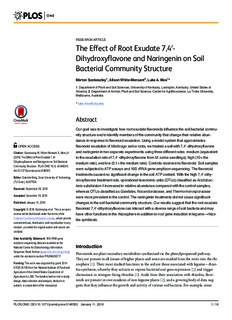
The Effect of Root Exudate 7, 40-Dihydroxyflavone and Naringenin on Soil Bacterial Community ... PDF
Preview The Effect of Root Exudate 7, 40-Dihydroxyflavone and Naringenin on Soil Bacterial Community ...
RESEARCHARTICLE 0 The Effect of Root Exudate 7,4 - Dihydroxyflavone and Naringenin on Soil Bacterial Community Structure MártonSzoboszlay1,AlisonWhite-Monsant2,LukeA.Moe1* 1 DepartmentofPlantandSoilSciences,UniversityofKentucky,Lexington,Kentucky,UnitedStatesof America,2 DepartmentofAnimal,PlantandSoilScience,CentreforAgriBioscience,LaTrobeUniversity, Melbourne,Australia *[email protected] a11111 Abstract Ourgoalwastoinvestigatehowrootexudateflavonoidsinfluencethesoilbacterialcommu- nitystructureandtoidentifymembersofthecommunitythatchangetheirrelativeabun- danceinresponsetoflavonoidexudation.Usingamodelsystemthatapproximates OPENACCESS flavonoidexudationofMedicagosativaroots,wetreatedasoilwith7,40-dihydroxyflavone Citation:SzoboszlayM,White-MonsantA,MoeLA andnaringeninintwoseparateexperimentsusingthreedifferentrates:medium(equivalent (2016)TheEffectofRootExudate7,40- totheexudationrateof7,40-dihydroxyflavonefromM.sativaseedlings),high(10×the DihydroxyflavoneandNaringeninonSoilBacterial mediumrate),andlow(0.1×themediumrate).Controlsreceivednoflavonoid.Soilsamples CommunityStructure.PLoSONE11(1):e0146555. weresubjectedtoATPassaysand16SrRNAgeneampliconsequencing.Theflavonoid doi:10.1371/journal.pone.0146555 treatmentscausednosignificantchangeinthesoilATPcontent.Withthehigh7,40-dihy- Editor:GabrieleBerg,GrazUniversityofTechnology droxyflavonetreatmentrate,operationaltaxonomicunits(OTUs)classifiedasAcidobac- (TUGraz),AUSTRIA teriasubdivision4increasedinrelativeabundancecomparedwiththecontrolsamples, Received:September26,2015 whereasOTUsclassifiedasGaiellales,Nocardioidaceae,andThermomonosporaceae Accepted:December19,2015 weremoreprevalentinthecontrol.Thenaringenintreatmentsdidnotcausesignificant Published:January11,2016 changesinthesoilbacterialcommunitystructure.Ourresultssuggestthattherootexudate Copyright:©2016Szoboszlayetal.Thisisanopen flavonoid7,40-dihydroxyflavonecaninteractwithadiverserangeofsoilbacteriaandmay accessarticledistributedunderthetermsofthe haveotherfunctionsintherhizosphereinadditiontonodgeneinductioninlegume—rhizo- CreativeCommonsAttributionLicense,whichpermits biasymbiosis. unrestricteduse,distribution,andreproductioninany medium,providedtheoriginalauthorandsourceare credited. DataAvailabilityStatement:16SrRNAgene ampliconsequencingdataareavailableatthe Introduction NationalCenterforBiotechnologyInformation SequenceReadArchive(www.ncbi.nlm.nih.gov/sra) Flavonoidsareplantsecondarymetabolitessynthesizedviathephenylpropanoidpathway. undertheaccessionnumberPRJNA295777. Theyarepresentinalltissuesofhigherplantsandsomeareexudedfromtherootsintotherhi- Funding:Thisworkwassupportedbygrant2011- zosphere[1].Theirmoststudiedfunctionsinthesoilarethoseassociatedwithlegume—rhizo- 67020-30195fromtheNationalInstituteofFoodand biasymbiosis,wherebytheyactivateorrepressbacterialnodgeneexpression[2]andtrigger AgricultureoftheUnitedStatesDepartmentof chemotaxisinnitrogen-fixingrhizobia[3].Asidefromtheirassociationwithrhizobia,flavo- AgriculturetoLAM.Thefundershadnoroleinstudy noidsarepresentinrootexudatesofnon-legumeplants[1],andagrowingbodyofdatasug- design,datacollectionandanalysis,decisionto publish,orpreparationofthemanuscript. geststhattheyinfluencethegrowthandactivityofvarioussoilbacteria.Forexample,some PLOSONE|DOI:10.1371/journal.pone.0146555 January11,2016 1/16 FlavonoidsandSoilBacterialCommunityStructure CompetingInterests:Theauthorshavedeclared flavonoids,particularlyisoflavonoids,areconsideredphytoalexinsorphytoanticipinsdueto thatnocompetinginterestsexist. theirantimicrobialeffect[4].Furthermore,theexperimentsofHartwigetal.[5]implythat rootexudateflavonoidsmaycontroltheproliferationofsomerhizospherebacteria.They foundthatthedoublingtimeofEnsifermelilotiandPseudomonasputidadecreasedwhen exposedtoluteolinorquercetininmicromolarconcentrationsinlaboratorycultures.Flavo- noidscanalsobeutilizedasasourceofcarbonandhaveotherdirectandindirecteffectson soilnutrientcycles[6].RootextractswithahighflavonoidcontentfromLupinusalbushave beenshowntodecreasesoilrespirationwithoutasignificantchangeinmicrobialbiomass basedonsoilATPcontent,andtodecreasephosphataseandincreaseureaseactivity[7].Flavo- noidsmayalsoaffectbacterialactivityintherhizospherebyinfluencingquorumsensing.Van- deputteetal.[8,9]foundthatcatechin,apigenin,eridictyol,kaempferol,luteolin,myricetin, naringenin,naringin,quercetin,taxifolin,andchalconehadsomeeffectontheproductionof quorum-sensing-dependentfactorsinPseudomonasaeruginosa.Further,Pérez-Montañoetal. [10]showedthatacyl-homoserine-lactoneproductionbyEnsiferfredii,Rhizobiumetli,andR. sullaestrainswasenhancedinthepresenceofflavonoidsthatareknowntoinduceexpression oftheircognatenodgenes. Thesefindingsindicatethatrootexudateflavonoidsinfluenceadiverserangeofsoilbacte- ria.Toimproveourunderstandingofhowrootexudateflavonoidsinfluencethesoilmicrobial communitystructure,wedesignedamodelsystemthatapproximatesflavonoidexudationof Medicagosativaroots.Ourgoalwastoidentifymembersofthesoilbacterialcommunitythat changetheirrelativeabundanceinresponsetoflavonoidexudation.Toachievethis,we 0 exploredtheimpactofsimulatedexudationof7,4-dihydroxyflavone,themostabundantnod geneinducingflavonoidamongtherootexudatesofM.sativaseedlings[11],andnaringenin, whichisalsoanodgeneinducingflavonoidpresentintherootexudatesofvariouslegumes [1]. MaterialsandMethods Soilproperties ThesoilchosenfortherhizospheremodelsystemstudieswasfromapastureattheUniversity ofKentuckySpindletopFarm(38°06'51.7"N,84°29'41.7"W)thathadnotbeenfertilizedor plantedforthelast5years;butpriortothis,M.sativahadbeengrownforthestudybyProbst andSmith[12].TheMaurysiltloam(fine,mixed,semiactive,mesicTypicPaleudalf)wascol- lectedfromthesurface10–15cm,sieved(4mm),driedatroomtemperaturewithregularmix- ing,andthenstoredatroomtemperatureinaclosedplasticcontainerforover3months.This storageperiodwastodecreasetheeffectofrootexudateflavonoidsinthesoilfromthevegeta- tionatthecollectionsite.SamplesweresenttotheUniversityofKentuckyRegulatoryServices SoilTestingLaboratorytodeterminebasicsoilproperties(http://soils.rs.uky.edu/tests/ methods.php). Thesoiltexturewas18.5%sand,64.1%silt,and17.4%clay.ThepHwas5.95(1:1solution: soilusing1MKCl)andthebufferedpHwas7.03(withSikorabuffer[13]).Thesoilcontained 4.49%organicmatterand0.25%totalnitrogen.Thecationexchangecapacitywas25.95meq/ 100g,thebasesaturation87.77%andtheexchangeableK,Ca,Mg,andNawere0.36,17.85, 4.55,and0.02meq/100g.MehlichIIIextractableP,K,Ca,Mg,andZnwere243.5,110.0, 2925.5,486.5,and1.2mg/kg. Beforeusingthesoilitwasmixedwith30%m/msand(previouslybleached,washed,and ovendried)tofacilitatedrainage. PLOSONE|DOI:10.1371/journal.pone.0146555 January11,2016 2/16 FlavonoidsandSoilBacterialCommunityStructure Therhizospheremodelsystem Thesoil—sandmixturewasmoistenedwithdistilledwater(60.0gwaterto400.0gsoil—sand mixture)andthoroughlymixedinplasticbagsbeforefilling60.0ginto50-mlpolypropylene conicalcentrifugetubes(FisherScientific,USA).Theconicalbottomportionsofthetubeswere previouslycutoffandreplacedwithplasticmeshtoallowdrainage.Eachtubewaswrappedin aluminumfoiltoprotectthesoilfromlight.Weusedrhizonsoilmoisturesamplers(Rhizon MOM,RhizosphereResearchProducts,Netherlands)tomodeltherootexudationprocess.The rhizonshad5-cmlongporousparts,2.5mmdiameter,poresize0.12–0.18μm,aglassfiber strengthener,andpolyethylene/polyvinylchloridetubing.Tothesoilineachtube,6.00mldis- tilledwaterwasaddedbeforeinsertingthreerhizonsverticallyandequidistanttoeachother andthewallofthetube.Therhizonswerepreviouslybleachedandthenwashedinsteriledis- tilledwater. Initialexperimentsstudyingtheeffectofrootexudatesonthesoilmicrobialcommunity deliveredexudatestothesoilviaartificialrootssuchasmembranefilters[14,15]orcylindrical tubesorwickspreparedfromsuchfilters[16,17].Inlaterexperiments,rhizonsoilmoisture samplerswereemployedasrootexudationmodels[18–20]byusingtheminthereversedirec- tion:topumpasolutionintothesoilinsteadofsamplingthesoilsolution.Analternative approachdevelopedbyZiegleretal.[21]usedglassslidescoatedwithagarosecontainingthe exudatecompoundsthatwereinsertedintothesoil.Ourgoalwastostudythemicrobialcom- munityinavolumeofsoilhomogenouslyexposedtotheexudates;therefore,weadoptedthe useofrhizonsoilmoisturesamplersinourrhizospheremodelsystems. Treatmentsolutionsandapplications 0 Therhizospheremodelsystemsreceived7,4-dihydroxyflavoneornaringeninathigh(24.00 nmol/day),medium(2.40nmol/day),low(0.24nmol/day),ornoflavonoid(control)rates.The mediumtreatmentratewasdeterminedfromthecalculationsofCescoetal.[1]whichwere 0 basedontheresultsofMaxwellandPhillips[11]tomatchtheexudationrateof7,4-dihydrox- yflavonefromM.sativaseedlingsassumingthat0.4g(freshweight)rootbiomassoccupiesthe soilinarhizospheremodelsystem.Wedeterminedtherootbiomassvalueexperimentallyby growingM.truncatulausingthesamesoilandtubesetupasthepresentexperiment(unpub- lished).Thetreatmentsolutionswereappliedin1.2mlaqueousvolumeslowlypumped throughtherhizons(400μlperrhizon)intothesoilusing1-mlsyringes,onceevery24hours. Aftereachapplication,approximately0.2mlofairwasinjectedintotherhizontoensurethat theentirevolumeofthetreatmentsolutionhadreachedthesoilandthatnoliquidremainedin thetubing. 0 Stocksolutionsof7,4-dihydroxyflavone(Indofine,USA)andnaringenin(MPBiomedicals, USA)werepreparedindimethylsulfoxideandstoredat−20°Cuntilthestartofthetreatments. Thefinaltreatmentsolutionseachcontained0.0625%v/vdimethylsulfoxide.Thetreatment solutionsforeachflavonoidtreatmentrateandthecontrolweresupplementedwiththemajor carbohydrates,aminoacids,andotherorganicacidspresentintherootexudatesofM.sativa [22–24]assuming0.4g(freshweight)rootbiomassintherhizospheremodelsystem:1396μM glucose,223μMarabinose,115μMmaltose,108μMmannose,690μMserine,250μMglycine, 26μMmalate,24μMcitrate,and4μMsuccinate.Stocksolutionswerepreparedinwater,filter sterilized(0.22μm),andstoredat4°C.Thecontroltreatmentsreceivedthecarbohydrates, aminoacids,andotherorganicacids,anddimethylsulfoxide,butnoflavonoid.Thetreatment solutionswereadjustedtopH7withKOH. Sixrhizospheremodelsystemsweresetupforeachofthehigh,medium,low,andcontrol treatmentrates,andthenplacedonplastictraysandincubatedinadarkcabinetatroom PLOSONE|DOI:10.1371/journal.pone.0146555 January11,2016 3/16 FlavonoidsandSoilBacterialCommunityStructure temperature(21–23°C).A400-μlaliquotofdistilledwaterwaspumpedthrougheachrhizon onceadayfor5daysbeforethetreatmentsstarted.Inthefirstdaysofincubationafewseed- 0 lingsgerminatedinthesoil.Thisaffected3rhizospheremodelsystemsreceivingthehigh7,4- dihydroxyflavonerate,1receivingthemediumrate,3receivingthelowrateand2receivingthe controltreatment.Fromthenaringenintreatments2rhizospheremodelsystemsreceivingthe highrate,1receivingthemediumrate,1receivingthelowrate,and2receivingthecontrol treatmentwereaffected.Seedlingswereremovedassoonastheyemergedfromthesoil.The lastseedlingappeared6daysbeforesampling.Thetreatmentswereappliedfor10days.Every 2daystherhizospheremodelsystemswereweighedbeforeadministeringthetreatmentsand thensufficientdistilledwaterwasappliedtothesoiltomaintainaconstantwatercontent,and theywererandomlyrearrangedonthetrays. 0 Theexperimentwasfirstconductedwith7,4-dihydroxyflavoneandthenrepeatedwithnar- ingeninusingthesameprocedures. Sampling Soilsampleswereharvestedapproximately3hoursafterthelasttreatmentapplication.The rhizonswereremovedandthesoilcolumnwaspushedoutofthetube.Thetop1cmofsoil wasdiscardedandthenext4cmwascollectedinasterileplasticbagusingasterilespatula, mixed,andthenfrozeninliquidnitrogen.Sampleswerestoredat−80°Cpriortoanalysingall samplesformicrobialbiomassandmicrobialcommunitystructure. Somerhizospheremodelsystemscontainedgerminatingseedsthatdidnotreachthesur- face,andthuswereonlydetectedduringsampling.Thesesystemswereremovedfromthe 0 studyleavingthenumberofreplicatesto5high,4medium,5low,and4controlinthe7,4- dihydroxyflavoneexperiment,and5high,5medium,4low,and5controlinthenaringenin experiment. ATPassays ToassesstotalmicrobialbiomassATPwasextractedfrom1.0gofthesoilsampleswith dimethylsulfoxideandtrisodiumphosphateasdescribedbyBaietal.[25],butwith1:10 insteadof1:100dilutioninglycine-EDTAbuffer.Dilutedextractsweretreatedwithbenzalko- niumchloridefollowingtheprotocolofMartens[26]bymixinga100-μlaliquotwith100μl 0.05%m/mbenzalkoniumchlorideinTris-Mg2+buffer(50mMTris,10mMMgSO ,pH7.8) 4 ina12mm×50mmautoclavedglasstube.Thetubewassonicatedfor5sand190μlTris- Mg2+bufferwasadded,followedby10μlStayBriteHighlyStableLuciferase/LuciferinReagent (BioVision,USA).Thesamplewasquicklymixedwithapipetandtheluminescencewasmea- suredfiveconsecutivetimesusingaTurnerDesign20/20luminometerwith10-sintegration periodsand54.8%sensitivity.Outofthefivemeasurements,generallythefirsttwowerehigher thanthelastthree,whichshowedlessvariation.Therefore,theaverageofthethird,fourth,and fifthreadingswasusedinthecalculation.Blankswereusedtomeasurethebackgroundlumi- nescenceusingglycine-EDTAbufferinsteadofasoilextract.Astandardcurveusinglog 10 (ATPconcentrationinnM)vs.log (luminescence)wasobtainedbymeasuringATPstan- 10 dardscomprisingblanksamplessupplementedwith0.1,0.5,1,5,and10nMATP.TheATP stocksolutionwaspreparedfromATP-Na salt(SERVAElectrophoresisGmbH,Germany)in 2 Tris-Mg2+bufferandthenfiltersterilized(0.22μm)andstoredat−80°C.Toestimatethe 0 extractionefficiency,soilsamplesfromthe7,4-dihydroxyflavone(n=3)andthenaringenin (n=3)experimentswererandomlychosen,andATPextractswerepreparedfromthemby adding20μl0.1mMATPsolutionwhenaddingthedimethylsulfoxide. PLOSONE|DOI:10.1371/journal.pone.0146555 January11,2016 4/16 FlavonoidsandSoilBacterialCommunityStructure 0 Samplesfromthe7,4-dihydroxyflavoneandnaringeninexperimentswereprocessedsepa- rately.ThreeblanksandasetofATPstandardsweremeasuredforbothexperiments.Theaver- ageoftheblankswassubtractedfromthereadingsandtheATPcontentpergramofsoil(dry weight)wascalculatedaccordingtothestandardcurvesinMicrosoftExcel.Theresultswere analyzedinJMP10.0.0(SASInstitute,USA)usingANOVAandTukey’sHSD. 16SrRNAgeneampliconsequencinganddataprocessing DNAwasextractedfrom250mgofsoilfromeachsamplewithPowerSoilDNAIsolationKit (MOBIOLaboratories,USA).TheV4regionofthe16SgenewasamplifiedwithPCRusing theprimersofKozichetal.[27].Thereactionscontained22.5μlAccuPrimePfxSuperMix (Invitrogen,USA),7.5ngDNA,and7.5pmolforwardandreverseprimers(IntegratedDNA Technologies,USA)in25μlfinalvolume.AmplificationwascarriedoutinaBio-RadMy Cyclerversion1.065thermocycler(Bio-Rad,USA)with4mininitialdenaturationat95°Cfol- lowedby30cyclesof20sat95°C,15sat55°C,and2minat68°C,andafinalextensionfor10 minat68°C.ThesizeandqualityofthePCRproductswerecheckedusingagarosegelelectro- phoresis.ThePCRproductswerecleaned,quantified,pooled,andsequencedonanIllumina MiSeqinstrumentwitha500cyclev2kit(Illumina,USA)attheUniversityofKentucky AdvancedGeneticsTechnologiesCenteraccordingtotheprotocolofKozichetal.[27].Sam- 0 plesfromthe7,4-dihydroxyflavoneandthenaringeninexperimentsweresequencedsepa- rately.ThesequencedataisaccessibleattheNationalCenterforBiotechnologyInformation SequenceReadArchive(www.ncbi.nlm.nih.gov/sra)undertheaccessionnumber PRJNA295777. Forwardandreversesequencereadswerejoined,andthensequencesthatwerelowquality, chimeric,mitochondrial,chloroplast,archaeal,eukaryotic,andunclassifiablewereremovedin mothurv1.34[28]asdescribedintheMiSeqSOP(http://www.mothur.org/wiki/MiSeq_SOP, accessedDecember2014)usingtheSILVAalignment[29]release119,andtheRibosomal DatabaseProject[30]release10.Sequenceswerebinnedtooperationaltaxonomicunits (OTUs)usingminimumentropydecomposition(MED)[31]withthefollowingsettings: m=0.0965,c=4,M=(numberofsequencesinthedataset/10000),andV=3.Arepresenta- tivesequencefromeachOTUwasclassifiedaccordingtotheRibosomalDatabaseProject release10usingmothurwith70%bootstrapcutoff. Insteadofrarefying[32],centeredlog-ratio(CLR)transformation[33,34]wasappliedto thedatamatricesusingthecompositionspackage[35]inRversion3.2.1(www.R-project.org). 0 Thedatamatricesfromthe7,4-dihydroxyflavoneandnaringeninexperimentscontained13 and43zeroes,respectively.Thesewerereplacedwithonestoallowthistransformation.Ordi- nationplotsweremadewithnon-metricmultidimensionalscaling(NMS)inPC-ORD6.0 (MJMSoftwareDesign,USA)withEuclideandistances:250runswereperformedwithrandom startingconfigurationsinonetosixdimensionswitha10−7instabilitycriterionand500maxi- mumiterationswith0.2initialsteplengthtofindthebeststartingconfigurationsineach dimensionality.Statisticsforthefinalstressforeachdimensionalitywereobtainedfrom250 runswithrandomizeddata.Dimensionswereonlyacceptediftheydecreasedthestresstoa lowervaluethanthatfrom95%oftherandomizedruns.Basedontheresults,two-dimensional solutionswereselected.Thefinalrunwasconductedusingthedeterminedbeststartingconfig- uration.Multi-responsepermutationprocedure(MRPP)[36]wasusedontheCLRtrans- formeddatasetswithEuclideandistancestotestthesignificanceofthedifferencesbetweenthe high,medium,low,andcontroltreatments.TofinddifferentiallyabundantOTUsinthetreat- ments,weusedDESeq2(withoutCLRtransformation)[37]asrecommendedbyMcMurdie etal.[32]withtheDESeq2packageversion1.8.1[37]inR.Toaccountforthehighnumberof PLOSONE|DOI:10.1371/journal.pone.0146555 January11,2016 5/16 FlavonoidsandSoilBacterialCommunityStructure Table1. SoilATPconcentrations,andestimatedATPextractionefficiency. 7,40-dihydroxyflavone(μg/gsoildryweight) Naringenin(μg/gsoildryweight) High 1.557±0.116 1.212±0.195 Medium 1.698±0.306 1.211±0.164 Low 1.780±0.101 0.983±0.062 Control 1.621±0.187 1.121±0.164 Extractionefficiency(%) 86.3±1.47 87.3±6.85 Numbersrepresentaverage±SD.ATPconcentrationsarenotcorrectedforextractionefficiency. doi:10.1371/journal.pone.0146555.t001 simultaneoustests,q-valueswerecalculatedaccordingtothepositivefalsediscoveryrate method[38]withthesmootheroptioninQVALUE(http://genomine.org/qvalue).Theq-value ofatestestimatestheproportionoffalsepositivefindingsinthedatasetiftestswithequalor lowerp-valuesareacceptedassignificant. Results ATPassays TherewasnosignificantdifferenceinthesoilATPcontentbetweenthetreatmentsineither 0 the7,4-dihydroxyflavoneorthenaringeninexperiment(Table1).Thestandardcurvesare showninS1Fig. 0 16Ssequencingresultsfromthe7,4-dihydroxyflavoneexperiment Thedatasetcontained117,276–359,427sequencespersamplewith253bpaveragereadlength, whichwerebinnedto1580OTUs.OntheNMSplot(Fig1A)thehigh,medium,andlowtreat- mentsamplesoverlappedeachother,butwereseparatefromthecontrolsamples,indicatinga 0 differenceinbacterialcommunitystructurebetweenthecontroland7,4-dihydroxyflavone treatments.Thisdifferencehowever,wasnotsignificantintheMRPPaftercorrectingformul- tiplecomparisons(Table2). WeusedDESeq2tofinddifferentiallyabundantOTUsinthecontrolcomparedwiththe mediumandhightreatments.ThesecomparisonsgavethehighestA-valuesintheMRPP (Table2).TheDESeq2resultsincludingthenormalizedmeanabundance,abundancefold change,p-andq-values,andthetaxonomicclassificationforallOTUsarelistedinS1Table (comparingthecontrolandhightreatments)andS2Table(comparingthecontroland mediumtreatments).Therewere37differentiallyabundantOTUsbetweenthecontroland hightreatmentswithq-valuesbelow0.1.Thisq-valueindicatestheproportionoffalsepositives iftheabundancesofalltheseOTUsareacceptedassignificantlydifferent.Thenormalized meanabundance,abundancefoldchange,p-values,andthetaxonomicclassificationofthese 37OTUsareshowninTable3. Fromthe37OTUs,14hadahigherrelativeabundanceinthehightreatmentthaninthe control.HalfoftheseOTUswereclassifiedasAcidobacteriasubdivision4(Table3).These sevenOTUscover18.9–22.8%oftheAcidobacteriasubdivision4sequencesinthehightreat- mentand14.1–17.2%inthecontrols.MostoftheOTUsinTable3thathadalowerrelative abundanceinthehightreatmentcomparedwiththecontrolwereclassifiedasActinobacteria. SixoftheseActinobacteriaOTUsbelongtogenusGaiella,togethercovering13.0–14.5%and 15.0–18.7%ofthesequencesfromthisgenusinthehighandcontroltreatments,respectively. PLOSONE|DOI:10.1371/journal.pone.0146555 January11,2016 6/16 FlavonoidsandSoilBacterialCommunityStructure Fig1.Non-metricmultidimensionalscaling(NMS)ordinationplots.(A)7,40-Dihydroxyflavoneexperiment,(B)naringeninexperiment.Pointsrepresent samples,crossesaregroupcentroids.Samplesofthesametreatmentareenclosedinconvexhulls.Stressiscalculatedonascaleof0to100.(Treatments: ●high,♦medium,&low,and▲control). doi:10.1371/journal.pone.0146555.g001 ThreeOTUswereclassifiedasNocardioidaceae,encompassing37.8–47.9%and46.3–59.5%of thesequencesfromOTUsclassifiedintothisfamilyinthehighandcontroltreatments,respec- tively.ThermomonosporaceaewasalsorepresentedbythreeOTUs,whichcontain69.3–77.6% and72.4–75.9%ofthesequencesfromthisfamilyinthehighandcontroltreatments, respectively. Inacomparisonofthecontrolwiththemediumtreatment,onlysixdifferentiallyabundant OTUshadq-valuesbelow0.1(S2Table).ThreeoftheseOTUs(OTU#886,10591,and12806) werealsodifferentiallyabundantbetweenthecontrolandthehightreatment(Table3).Twoof theotherthreeOTUswereclassifiedasMicromonosporaceaeandAcidobacteriasubdivision 16,andonecouldnotbeclassifiedatphylumlevelwithhigherthan70%bootstrapsupport. SeveralOTUslistedinTable3thathadsignificantlydifferentabundancesbetweenthecontrol andhightreatmentshowedasimilarresponseinthemediumtreatmentcomparedwiththe control.FromtheAcidobacteriasubdivision4OTUslistedinTable3thatweresignificantly moreabundantinthehightreatmentthaninthecontrol,OTU#10591,13198,and11314were alsomoreabundantinthemediumtreatmentcomparedwiththecontrolandhadlowq-values (0.049,0.115,and0.115,respectively)(S2Table).OTU#11842and14169wereclassifiedas Gaiella,OTU#4243and9952wereclassifiedasNocardioidaceae,andOTUs11413and9555 wereclassifiedasThermomonosporaceae(Table3).Similartothecontrolversushightreatment comparison,theseOTUshadhigherrelativeabundanceinthecontrolthaninthemedium treatmentandhadq-valuesof0.176,0.209,0.115,0.163,0.171,and0.202,respectively(S2 Table). PLOSONE|DOI:10.1371/journal.pone.0146555 January11,2016 7/16 FlavonoidsandSoilBacterialCommunityStructure Table2. Multi-responsepermutationprocedure(MRPP)results. Comparison A p Correctedp 7,40-dihydroxyflavone control—low -0.00039 0.4435 2.6608 control—medium 0.02922 0.0446 0.2674 control—high 0.02306 0.0333 0.1997 low—medium 0.00497 0.3274 1.9642 low—high -0.00054 0.4464 2.6781 medium—high -0.01322 0.9229 5.5374 Naringenin control—low 0.00323 0.3482 2.0890 control—medium -0.01677 0.7711 4.6265 control—high -0.02264 0.9584 5.7502 low—medium 0.00028 0.4185 2.5113 low—high 0.00403 0.3345 2.0068 medium—high -0.01294 0.7590 4.5542 TheA-valuesarethechance-correctedwithin-groupagreementsanddescribetheeffectsize.Correctedp-valueswerecalculatedusingtheBonferroni method. doi:10.1371/journal.pone.0146555.t002 16Ssequencingresultsfromthenaringeninexperiment Thedatasetcontained149,471–339,727sequencespersamplewith253bpaveragereadlength. TheMEDresultedin1589OTUs.Interestingly,thecontrolsamplesshowednoseparation fromthehighormediumtreatmentsintheNMSplot,butthelowtreatmentappearedtosepa- rate(Fig1B).Thisdifferencehowever,wasnotsignificantintheMRPP(Table2).Thecompar- isonsbetweenthelowandhightreatmentsandbetweenthecontrolandlowtreatments resultedinthelargesteffectsizesintheMRPP(Table2);thustheywereinvestigatedwith DESeq2tofinddifferentiallyabundantOTUs.Thenormalizedmeanabundance,abundance foldchange,p-andq-values,andthetaxonomicclassificationforallOTUsarelistedinS3 Table(comparingthecontrolandlowtreatments)andS4Table(comparingthelowandhigh treatments).OnlythreeOTUshadsignificantlydifferentabundancesbetweenthecontroland thelowtreatmentandhadq-valuesbelow0.1(S3Table).OneOTUwasclassifiedasBacillus, oneasGaiella,andonewasnotpossibletoclassifyatthephylumlevelwithhigherthan70% bootstrapsupport.ComparisonofthelowandthehightreatmentsresultedinfourOTUswith significantlydifferentabundancesandwithq-valuesbelow0.1(S4Table).Thesewereclassified intoOxalobacteraceae,Intrasporangiaceae,Acidobacteriasubdivision6,andChitinophagaceae. Discussion SoilATPcontentisameasureofthetotallivingmicrobialbiomassincludingactiveanddor- 0 mantorganisms[39].The7,4-dihydroxyflavoneandnaringenintreatmentshadnosignificant effectontheATPcontentofthesoil.Thissuggeststhatthechangeinrelativeabundanceof OTUsfoundinDESeq2isduetoagrowthresponseofthoseparticularbacterialgroupsandis notduetoageneralantimicrobialorgrowthpromotingeffectontheothermembersofthe bacterialcommunity.HoweverwenotethatsoilATPcontentreflectsthebiomassofallsoil organisms,includingfungi,othereukaryoticmicrobes,andArchaea,whicharenotrepresented inour16Ssequencingresults. NaringeninhasbeenshowntoinhibitthegrowthofavarietyofGrampositiveandnegative bacteriaaswellasSaccharomycescerevisiaewithminimuminhibitoryconcentrationsranging PLOSONE|DOI:10.1371/journal.pone.0146555 January11,2016 8/16 FlavonoidsandSoilBacterialCommunityStructure a s Genus Nocardioides Pseudonocardi Janibacter Actinoallomuru Gaiella Gaiella Conexibacter Gaiella Gaiella Kribbella Gaiella Gaiella Adhaeribacter Flavisolibacter Onlytaxonomic econtrol. h 0<qentsforthe7,4-dihydroxyflavoneexperiment(-values0.1). ClassisOrdoFamilia ActinobacteriaActinomycetalesNocardioidaceae ActinobacteriaActinomycetalesThermomonosporaceae ActinobacteriaActinomycetalesPseudonocardiaceae ActinobacteriaActinomycetalesIntrasporangiaceae ActinobacteriaActinomycetalesThermomonosporaceae ActinobacteriaGaiellalesGaiellaceae ActinobacteriaGaiellalesGaiellaceae ActinobacteriaSolirubrobacteralesConexibacteraceae BacilliBacillales ActinobacteriaActinomycetalesNocardioidaceae ActinobacteriaGaiellalesGaiellaceae ActinobacteriaSolirubrobacterales ActinobacteriaGaiellalesGaiellaceae ActinobacteriaActinomycetalesNocardioidaceae ActinobacteriaActinomycetalesThermomonosporaceae AlphaproteobacteriaRhizobiales ActinobacteriaGaiellalesGaiellaceae Subdivision17 AlphaproteobacteriaRhodospirillales ActinobacteriaGaiellalesGaiellaceae Subdivision4 Subdivision4 Subdivision4 CytophagiaCytophagalesCytophagaceae Subdivision4 Subdivision6 Subdivision4 Subdivision4 SphingobacteriiaSphingobacterialesChitinophagaceae SphingobacteriiaSphingobacterialesChitinophagaceae Subdivision4 fiTUclassiedaccordingtotheRibosomalDatabaseProjectrelease10. geofthenormalizedabundanceinthehightreatmentcomparedwitht m O an ntrolandhightreat Phylum Actinobacteria0 Actinobacteria5 Actinobacteria2 Actinobacteria4 Actinobacteria1 Actinobacteria1 Actinobacteria5 Actinobacteria8 Actinobacteria8 Actinobacteria3 Firmicutes2 Actinobacteria1 Actinobacteria4 Actinobacteria1 Actinobacteria6 Actinobacteria5 Actinobacteria3 Proteobacteria5 Actinobacteria5 Acidobacteria3 Proteobacteria1 Actinobacteria0 Acidobacteria6fi1unclassied Acidobacteria7 Acidobacteria9 Bacteroidetes7 Bacteroidetes5 Acidobacteria4 Acidobacteria2 Acidobacteria7fi4unclassied Acidobacteria2 Bacteroidetes5 Bacteroidetes3 Acidobacteria1 uencesfromeach angeisthefoldch o 2 1 2 1 8 0 2 2 4 3 8 1 1 5 4 5 7 2 4 6 2 1 9 2 3 8 3 5 8 2 1 2 6 5 9 3 q h c 0 1 1 3 3 5 5 5 7 2 2 4 4 6 9 0 0 5 6 6 7 8 0 2 6 2 3 5 5 6 7 8 0 4 6 0 e c weenthe p 0.000 0.000 0.000 0.000 0.000 0.000 0.000 0.000 0.000 0.001 0.001 0.001 0.001 0.001 0.001 0.002 0.002 0.002 0.002 0.002 0.002 0.002 0.000 0.000 0.000 0.001 0.001 0.001 0.001 0.001 0.001 0.001 0.002 0.002 0.002 0.003 ntatives ed.Fold bet ge 7 1 1 2 5 2 4 6 2 5 0 6 5 3 4 6 8 1 3 9 9 3 1 5 2 5 1 6 8 1 3 9 4 7 5 7 ese list ntOTUs FoldChan 0.5 0.6 0.6 0.6 0.5 0.6 0.6 0.6 0.6 0.6 0.6 0.5 0.5 0.6 0.6 0.6 0.5 0.6 0.6 0.6 0.5 0.6 1.9 2.0 1.6 1.4 1.8 1.8 1.4 1.7 1.5 1.7 1.4 1.6 1.4 1.4 donrepr pportare a e u d s s abun edce 2.3 7.7 8.4 9.0 7.8 6.3 9.8 1.8 1.7 1.0 9.9 1.2 0.5 3.2 3.5 4.3 9.6 3.7 7.4 4.3 6.2 6.2 7.6 9.0 2.8 7.0 8.5 4.7 2.3 3.4 2.7 0.5 0.7 7.4 1.3 3.9 asba strap Table3.DESeq2results.Differentially OTU#MeanNormalizAbundan Moreabundantin424314thecontrol1280619treatment1141333 999338 85354 316015 955517 1184269 1365711 903015 412131 99524 57953 327316 598515 1011214 95574 74515 141699 547739 38196 141707 Moreabundantin131985thehightreatment29451 1131415 1354722 8862 123405 1059168 133585 1136414 503 13562127 111095 1232317 564920 ficationoftheOTUswTaxonomicclassi assignmentswithhigherthan70%boot doi:10.1371/journal.pone.0146555.t003 PLOSONE|DOI:10.1371/journal.pone.0146555 January11,2016 9/16 FlavonoidsandSoilBacterialCommunityStructure from250to1000μg/ml[40–42].Abroad-spectruminhibitionofgrowthwouldlikelycausea decreaseinsoilATPcontent,butthisdidnotoccur.Thehighflavonoidtreatmentsolutionin ourexperimenthadaconcentrationof5.45μg/ml,whichisabouttwomagnitudeslowerthan thereportedminimuminhibitoryconcentrationsfornaringenin.Itseemslikelythatsomeroot exudateflavonoidsthathavebeenconsideredantimicrobialbasedonlaboratoryculturestudies donotfunctionasinhibitorsofbacterialgrowthinthesoil.Thisissimplybecausethedeter- minedminimuminhibitoryconcentrationsarehigherthanthoseexpectedintherhizosphere, ortheyonlyhaveanantimicrobialeffectadjacenttothesiteofexudation,suchasintherhizo- planewheretheirlocalconcentrationsmaybehigh. ForsoilswithasimilartextureandpHtotheMaurysiltloamusedinthepresentstudy,Bai etal.[25]reportedasoilATPcontentof0.76–2.20μg/g.Ourresultsusingthesameextraction methodalsooccurredwithinthisrange(Table1).However,Baietal.didnotincubatetheir soilswithcarbonsourcesbeforeextraction,whereasoursamplesweretreateddailyfor10days withamixtureofcarbohydratesandorganicacids,whichshouldpromotethegrowthofhet- erotrophicmicroorganisms,andthusincreasethemicrobialbiomassandATPcontent.In theirreview,BlagodatskayaandKuzyakov[39]concludedthatanATPcontentbelow1–2μg/g soiliscommonwhenthesoilmicrobialcommunityisnotactivated,andthattheadditionof readilyavailablesubstrates,suchasglucose,causesseveral-foldincreases,whichimpliesthat ourresultsarelowerthanexpected.AlikelyexplanationfortherelativelylowATPcontentof oursamplesisthatthetreatmentsolutionaddedonly0.0040mgcarbonpergsoildailyasglu- coseandothersubstrates,whichisaboutthreemagnitudeslessthantheamountusedinother studiestoactivatethesoil[43,44].TheconcentrationsofcarbonsourcesandtheC:Nratiosin ourtreatmentsolutionswereclosertothoseusedbyDrakeetal.[18]intheirC+Ntreatment (carbonat500mg/lversus172.3mg/linthepresentstudy,C:Nof10versus13.1inthepresent study),whichdidincreasesoilmicrobialbiomasssignificantly,butnotseveral-foldasreported byBlagodatskayaandKuzyakov[39]. 0 7,4-Dihydroxyflavoneisknownforitsabilitytoinducetheexpressionofnodgenesinspe- cieslikeRhizobiumleguminosarumbv.trifolii[45],Ensifermeliloti[46],andBradyrhizobium japonicum[47].TherearenumerousOTUsinourdatasetclassifiedasRhizobiumandBradyr- hizobium(S1Table),andthesoiloriginatedfromasitewhereM.sativahadbeengrownfor 0 years.Therefore,itislikelythatrhizobialspeciesabletoreactto7,4-dihydroxyflavoneasanod geneinducerwerepresentinthesoilmicrobialcommunity.However,weonlyfoundasingle OTUclassifiedasRhizobialesthatsignificantlychanged(q-value<0.1)itsrelativeabundance 0 inthehigh7,4-dihydroxyflavonetreatmentcomparedwiththecontrol(Table3),andthe abundanceofthisOTUdecreasedintheflavonoidtreatment.Thisimpliesthatnodgene 0 inductioninbacteriaby7,4-dihydroxyflavoneisnotnecessarilycoupledwithsignificant growthpromotion.OurresultsconcurwithHartwigetal.[5],whofoundthat10μM7,40-dihy- droxyflavonedidnotaffectthedoublingtimeintheculturesofR.leguminosarumbv.trifolii andE.meliloti. OurresultsshowthatalargeportionoftheAcidobacteriasubdivision4communityinthe 0 soilincreaseditsrelativeabundanceinthehigh7,4-dihydroxyflavoneflavonoidtreatment. Basedonculture-independentstudies,Acidobacteriaisoneofthemostabundantbacterial phylaintherhizosphere[48],andsubdivision4isamongthemostdominantofthe26subdivi- sionsinawidediversityofsoils,especiallyinsoilswithlowacidity[49].However,thereare onlythreevalidlydescribedspeciesinthistaxon[50–52],whichimpedesourunderstandingof theirmetabolismandactivity.InclonelibrariesconstructedfromtherhizosphereofNoccaea caerulescensandfromunplantedbulksoilthatwascontaminatedwithheavymetals,fewer clonesfromsubdivision4werefoundintherhizospherecomparedwiththebulksoil[53].The abundanceofvariousacidobacterialsubdivisionsinunplantedsoilandintherhizospheresof PLOSONE|DOI:10.1371/journal.pone.0146555 January11,2016 10/16
Description: